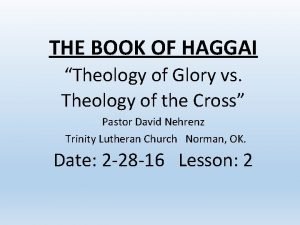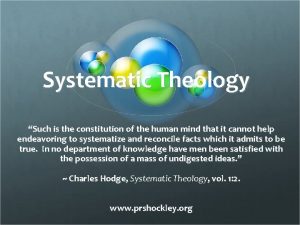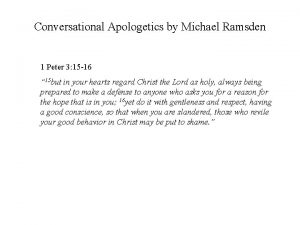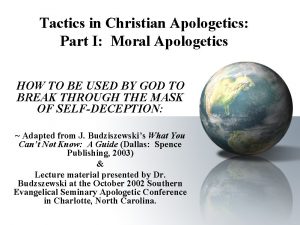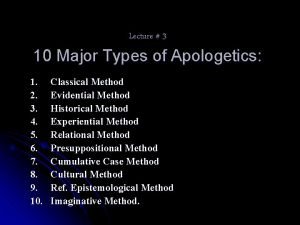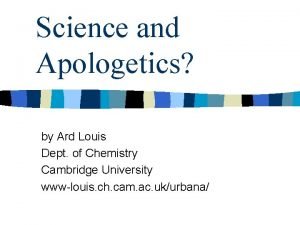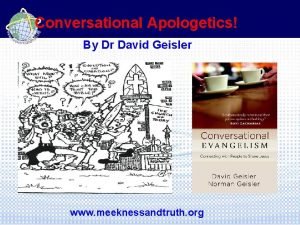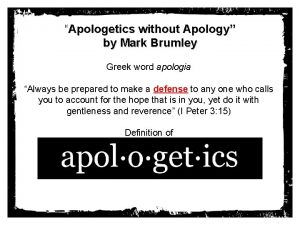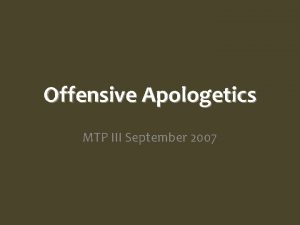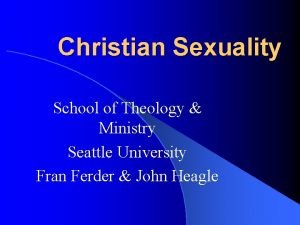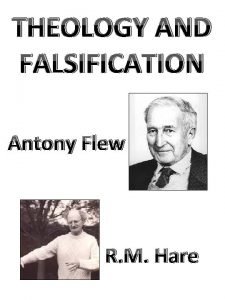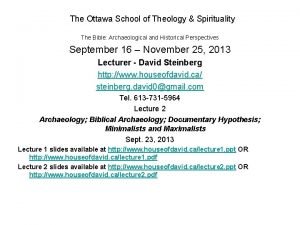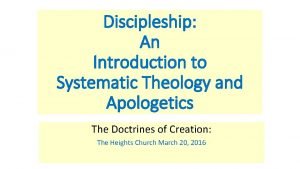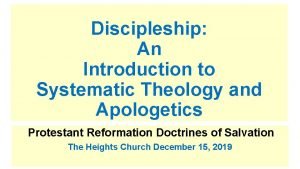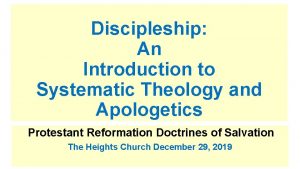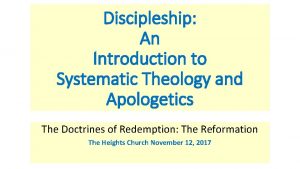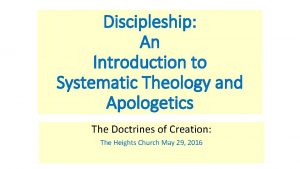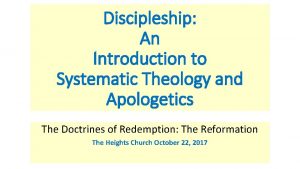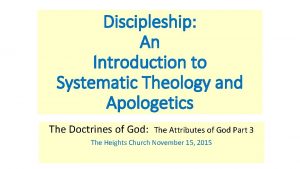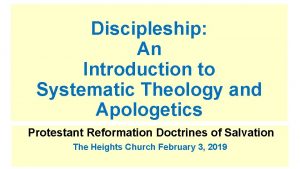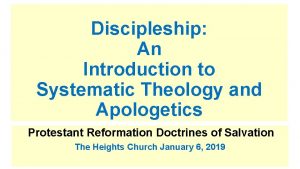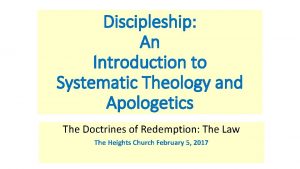Discipleship An Introduction to Systematic Theology and Apologetics












- Slides: 12

Discipleship: An Introduction to Systematic Theology and Apologetics The Doctrines of Redemption: The Reformers The Heights Church March 18, 2018

The Reformation – The Council of Trent: December 13, 1545 – December 4, 1563 • On March 15, 1517, the Fifth Council of the Lateran closed its activities with a number of reform proposals (on the selection of bishops, taxation, censorship and preaching) but not on the major problems that confronted the Church in Germany and other parts of Europe. • During the reign of Pope Clement VII (1523– 34), troops of the Holy Roman Emperor Charles V sacked Papal Rome in 1527, raping, killing, burning, stealing, the like had not been since the Vandals. Saint Peter's Basilica and the Sistine Chapel were used for horses stables. • Charles V strongly favored a council, but needed the support of King Francis I of France, who attacked him militarily. Francis I generally opposed a general council due to partial support of the Protestant cause within France, and in 1533 he further complicated matters when suggesting a general council to include both Catholic and Protestant rulers of Europe that would devise a compromise between the two theological systems. • After much jockeying between Charles V and the Vatican over the location the council convened in Trent in NE Italy.

The Reformation – The Council of Trent: December 13, 1545 – December 4, 1563 • Pope Paul III presided over the first eight sessions (1545– 47), Pope Julius III oversaw the twelfth to sixteenth sessions (1551– 52) and Pope Pius IV presided over the seventeenth to twenty-fifth sessions (1562– 63). However, none of the three popes reigning over the council ever attended, which had been a condition of Charles V. • The Council was not well attended opening with only about 30 bishops. It increased toward the close, but never reached the number of the First Council of Nicaea (318) nor of the First Vatican Council (744). The decrees were signed in 1563 by 255 members, the highest attendance of the whole council. • A few Protestants were invited to the second session but had little to no influence. • The Council issued condemnations of what it defined to be heresies committed by Protestantism and key statements and clarifications of the Church's doctrine and teachings, including scripture, the Biblical canon, sacred tradition, original sin, justification, salvation, the sacraments, the Mass and the veneration of saints. • The Council made the Vulgate the official Biblical canon and commissioned the creation of a standard version that was finished in the 1590’s.

The Reformation – The Council of Trent: December 13, 1545 – December 4, 1563 • The rite of reception of baptized Christians into the Communion of the Catholic Church states that "one who was born and baptized outside the visible communion of the Catholic Church is not required to make an abjuration of heresy publicly but simply a profession of faith. (Normally, an abjuration of heresy is made in the privacy of the confessional. ) After joining with the congregation in reciting the Nicene Creed, the person being received into the Catholic Church makes the following profession of faith: I believe and profess all that the holy Catholic Church believes, teaches, and proclaims to be revealed by God. • The doctrinal acts are as follows: after reaffirming the Nicene Creed (third session), • confirming that the deuterocanonical books were on a par with the other books of the canon (against Luther's placement of these books in the Apocrypha of his edition) and coordinating church tradition with the Scriptures as a rule of faith. (fourth session) • The Vulgate translation was affirmed to be authoritative for the text of Scripture.

The Reformation – The Council of Trent: December 13, 1545 – December 4, 1563 • Justification (sixth session) was declared to be offered upon the basis of human cooperation with divine grace as opposed to the Protestant doctrine of passive reception of grace. Understanding the Protestant "faith alone" doctrine to be one of simple human confidence in divine mercy, the Council rejected the "vain confidence" of the Protestants, stating that no one can know who has received the grace of God. Furthermore, the Council affirmed— against Protestant doctrine—that the grace of God can be forfeited through mortal sin. • Ordination (twenty-third session) was defined to imprint an indelible character on the soul. The priesthood of the New Testament takes the place of the Levitical priesthood. To the performance of its functions, the consent of the people is not necessary. • In the decrees on marriage (twenty-fourth session) the excellence of the celibate state was reaffirmed, concubinage condemned and the validity of marriage made dependent upon the wedding taking place before a priest and two witnesses, although the lack of a requirement for parental consent ended a debate that had proceeded from the 12 th century. In the case of a divorce, the right of the innocent party to marry again was denied so long as the other party was alive, even if the other party had committed adultery. However the council "refused … to assert the necessity or usefulness of clerical celibacy.

The Reformation – The Council of Trent: December 13, 1545 – December 4, 1563 • In the twenty-fifth and last session, the doctrines of purgatory, the invocation of saints and the veneration of relics were reaffirmed, as was also the efficacy of indulgences as dispensed by the Church according to the power given her, but with some cautionary recommendations, and a ban on the sale of indulgences. Short and rather inexplicit passages concerning religious images, were to have great impact on the development of Catholic Church art. Much more than the Second Council of Nicaea (787) the Council fathers of Trent stressed the instructional purpose of Christian images. • The council appointed, in 1562 (eighteenth session), a commission to prepare a list of forbidden books but it later left the matter to the Pope. The preparation of a catechism and the revision of the Breviary and Missal were also left to the pope. The catechism embodied the council's far-reaching results, including reforms and definitions of the sacraments, the Scriptures, church dogma, and duties of the clergy. • For example, on March 18 the missal readings are: Psalms 51: 3 -4, 12 -13, 14 -15, John 12: 2033 and, Hebrews 5: 7 -9

The Reformation – The Council of Trent: December 13, 1545 – December 4, 1563 • On March 11 the Missal readings included Ephesians 2: 4 – 10! But God, being rich in mercy, because of the great love with which he loved us, even when we were dead in our trespasses, made us alive together with Christ - by grace you have been saved and raised us up with him and seated us with him in the heavenly places in Christ Jesus, so that in the coming ages he might show the immeasurable riches of his grace in kindness toward us in Christ Jesus. For by grace you have been saved through faith. And this is not your own doing; it is the gift of God, not a result of works, so that no one may boast. For we are his workmanship, created in Christ Jesus for good works, which God prepared beforehand, that we should walk in them. (ESV) For by grace you are saved through faith, and that not of yourselves, for it is the gift of God; Not of works, that no man may glory. For we are his workmanship, created in Christ Jesus in good works, which God hath prepared that we should walk in them. (Ephesians 2: 8 -10 New American Bible*) *official Roman Catholic Bible as derived from the Latin Vulgate

The Reformation – The Council of Trent: December 13, 1545 – December 4, 1563 • The greatest weight in the Council's decrees was given to the sacraments. The seven sacraments were reaffirmed and the Eucharist pronounced to be a true propitiatory sacrifice as well as a sacrament, in which the bread and wine were consecrated into the Eucharist (thirteenth and twenty-second sessions). • The term transubstantiation was used by the Council, but the specific Aristotelian explanation given by Scholasticism was not cited as dogmatic. Instead, the decree states that Christ is "really, truly, substantially present" in the consecrated forms. • The sacrifice of the Mass was to be offered for dead and living alike and in giving to the apostles the command "do this in remembrance of me, " Christ conferred upon them a sacerdotal power. • The practice of withholding the cup from the laity was confirmed (twenty-first session) as one which the Church Fathers had commanded for good and sufficient reasons; yet in certain cases the Pope was made the supreme arbiter as to whether the rule should be strictly maintained. • On the language of the Mass, "contrary to what is often said", the council condemned the belief that only vernacular languages should be used, while insisting on the use of Latin.

The Reformation – The Council of Trent: December 13, 1545 – December 4, 1563 • On adjourning, the Council asked the supreme pontiff to ratify all its decrees and definitions. This petition was complied with by Pope Pius IV, on 26 January 1564, in the papal bull, Benedictus Deus, which enjoins strict obedience upon all Catholics and forbids, under pain of excommunication, all unauthorized interpretation, reserving this to the Pope alone and threatens the disobedient with "the indignation of Almighty God and of his blessed apostles, Peter and Paul. " Pope Pius appointed a commission of cardinals to assist him in interpreting and enforcing the decrees.

The Reformation – Summary of Major Post Trent European Religious Wars Date 1562 1598 1568 1648 Name French Wars of Religion Eighty Years War 1618 - Thirty Years 1648 War 1639 - War of Three 1651 Kingdoms ~ Death Toll Summary of the conflict 3, 000 Religious war between Protestants (mainly reformed ) and Catholics. 1, 200, 000 Religious war between Protestants (mainly reformed ) and Catholics in the Low Countries of the Holy Roman Empire. 7, 250, 000 Initially a religious war between Protestants (Lutheran and Reformed) and Catholics in the fragmented Holy Roman Empire. It became a French-Habsburg War for European political pre-eminence. 500, 000 Civil, religion-state relation and religious freedom issues, with a national element involving Great Britain and Ireland.

The Reformation – Counter Reformation/ Catholic Revival • The Counter-Reformation was the Catholic resurgence beginning with the Council of Trent (1545– 1563) and ending at the close of the Thirty Years' War (1648). • Key events following Trent included: • foundation of seminaries for the proper training of priests • new mystic/spiritual movements focusing on the devotional life and a personal relationship with Christ • a mission to reach parts of the world that had been colonized as predominantly Catholic and also an attempt to reconvert areas such as Sweden and England • Spanish Inquisition (November 1, 1478 – July 15, 1834) • Roman Inquisition (1542 – 1858) • First attempt by the Jesuits to reach China (1552) • Excommunication of Elizabeth I (1570) • Adoption of the Gregorian Calendar (1582) • Execution of Giordano Bruno (1600) • Trial of Galileo (1633)

The Reformation – Vatican I and II • Vatican I ( December 8, 1869 - October 20, 1870) • Its best-known decision is its definition of papal infallibility. • Reaffirmed the decisions at Trent to address modern issues of rationalism, liberalism and materialism. • Vatican II (October 11, 1962 - December 8, 1965) • Ecumenicalism • Mass in the vernacular language • Interest in reading the Bible
 Book of haggai
Book of haggai Biblical theology
Biblical theology Conversational apologetics michael ramsden
Conversational apologetics michael ramsden Moral apologetics
Moral apologetics Types of apologetics
Types of apologetics Apologetics
Apologetics Conversational apologetics
Conversational apologetics Apologetics
Apologetics Offensive apologetics
Offensive apologetics Antony flew theology and falsification
Antony flew theology and falsification Seattle university school of theology and ministry
Seattle university school of theology and ministry Antony flew theology and falsification
Antony flew theology and falsification Ottawa school of theology and spirituality
Ottawa school of theology and spirituality
